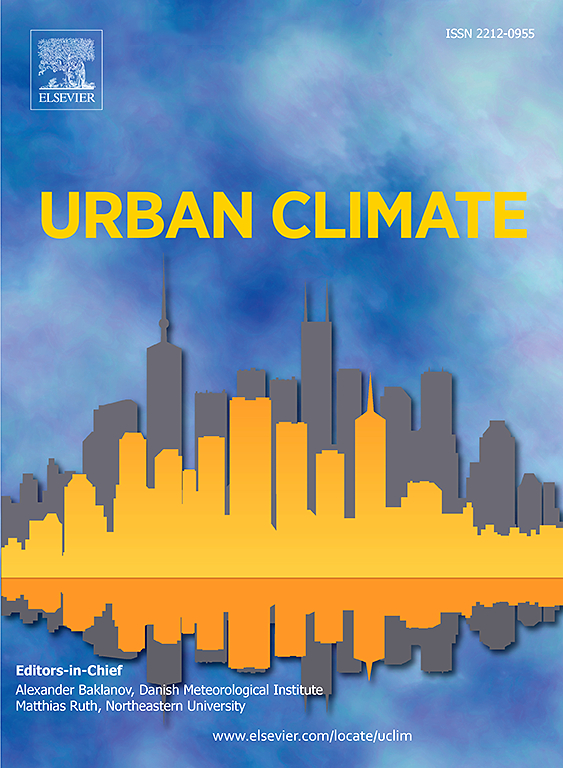How can street interface morphology effect pedestrian thermal comfort: A case study of the old town of Changsha, China
IF 6
2区 工程技术
Q1 ENVIRONMENTAL SCIENCES
引用次数: 0
Abstract
The challenge of the urban thermal environment stands as a pivotal obstacle in enhancing urban habitation, with its most conspicuous manifestation occurring during the summer months. The urban configuration intertwines with the thermal milieu, and its meticulous refinement is critical to ameliorating thermal conditions. Notably, streets, constituting two-thirds of the urban expanse, assume paramount importance. Delving into the nexus between street interface morphology and the thermal environment carries practical implications. The current corpus of street form research exhibits a conspicuous oversight in attending to the street interface, with a noticeable need for more exploration into its symbiosis with the thermal ambience. This study, therefore, directs its focus toward the nuanced examination of street interface morphology. Employing the method of constructing morphological models, we utilize ENVI-met software to simulate and analyze the thermal environment. The Universal Thermal Climate Index (UTCI) serves as the yardstick for evaluating thermal conditions, elucidating the influence of street interface morphology on the summer thermal environment of streets. The findings unveil a discernible correlation: for east-west streets, diminished interface density and concavity, coupled with an augmented street aspect ratio and interface height dislocation, yield superior street pedestrian thermal comfort. The interface height ratio index emerges as a particularly noteworthy factor, with the nadir of thermal comfort occurring at an interface height ratio1. Moreover, streets boasting elevated interfaces on the north side exhibit enhanced thermal comfort within similar interface height ratios. In the case of north-south streets, heightened interface density and street aspect ratio, juxtaposed with diminished interface concavity and height dislocation, parallelly yield enhanced thermal comfort. Optimal thermal comfort materializes when the interface height ratio equals 1. Moreover, streets featuring elevated interfaces on the east side manifest superior thermal comfort within equivalent interface height ratios. The culminating phase of this inquiry entails the optimization simulation of select streets within the ancient precincts of Changsha. The outcomes underscore a discernible enhancement in the thermal comfort of both east-west and north-south streets post-optimization, affirming the efficacy of street interface shape transformations in efficaciously augmenting the summer thermal environment of urban streets.
街道界面形态对行人热舒适的影响——以长沙老城区为例
城市热环境的挑战是增强城市居住的关键障碍,其最明显的表现出现在夏季。城市结构与热环境交织在一起,其细致的细化对改善热条件至关重要。值得注意的是,街道占城市面积的三分之二,具有至高无上的重要性。深入研究街道界面形态与热环境之间的联系具有实际意义。目前的街道形态研究在关注街道界面方面表现出明显的疏忽,需要更多地探索其与热环境的共生关系。因此,本研究将重点放在街道界面形态的细致检查上。采用构造形态模型的方法,利用ENVI-met软件对热环境进行模拟分析。通用热气候指数(Universal Thermal Climate Index, UTCI)作为评价热条件的尺度,阐明了街道界面形态对街道夏季热环境的影响。研究结果揭示了一个明显的相关性:对于东西方向的街道,界面密度和凹凸度的减少,加上街道宽高比和界面高度错位的增加,产生了优越的街道行人热舒适性。界面高度比指数是一个特别值得注意的因素,热舒适的最低点出现在界面高度比1处。此外,北侧具有高架界面的街道在相似的界面高度比下表现出增强的热舒适性。在南北街道的情况下,界面密度和街道宽高比的增加,以及界面凹凸度和高度错位的减少,同时提高了热舒适性。界面高度比为1时热舒适性最佳。此外,东侧具有高架界面的街道在等效界面高度比下表现出优越的热舒适性。该研究的最后阶段需要对长沙古代区域内选定的街道进行优化模拟。结果强调了优化后东西和南北街道的热舒适性的明显增强,肯定了街道界面形状转换在有效增强城市街道夏季热环境方面的有效性。
本文章由计算机程序翻译,如有差异,请以英文原文为准。
求助全文
约1分钟内获得全文
求助全文
来源期刊

Urban Climate
Social Sciences-Urban Studies
CiteScore
9.70
自引率
9.40%
发文量
286
期刊介绍:
Urban Climate serves the scientific and decision making communities with the publication of research on theory, science and applications relevant to understanding urban climatic conditions and change in relation to their geography and to demographic, socioeconomic, institutional, technological and environmental dynamics and global change. Targeted towards both disciplinary and interdisciplinary audiences, this journal publishes original research papers, comprehensive review articles, book reviews, and short communications on topics including, but not limited to, the following:
Urban meteorology and climate[...]
Urban environmental pollution[...]
Adaptation to global change[...]
Urban economic and social issues[...]
Research Approaches[...]
 求助内容:
求助内容: 应助结果提醒方式:
应助结果提醒方式:


